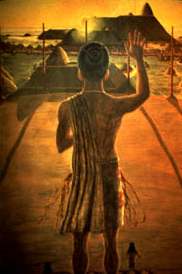
Priest-chief greets "his brother", the rising sun.
|
To a large degree religious beliefs and world view define acceptable and
unacceptable behaviors and ways of thinking for members of a society. That is,
a people's world view forms a central organizing device for structuring
behavior and coping with change. A chief is often viewed as god-like serving as
the medium for communication with the supernatural in the upper and lower
worlds (see below). As such, the elite will manipulate religious beliefs and
world view to gain social control for themselves, their family or the chiefly
corporate group.
Thus, it should not be surprising that commoners might be coerced by ritual
sanctions and physical threats (convinced by custom or threat of dire
consequences if they did not) into providing the chief and his retainers food
surplus and labor to insure poorly understood natural events and conditions
like the rising of the sun, adequate rain, good crops, adequate fish harvests,
and general well-being of the population.
|
